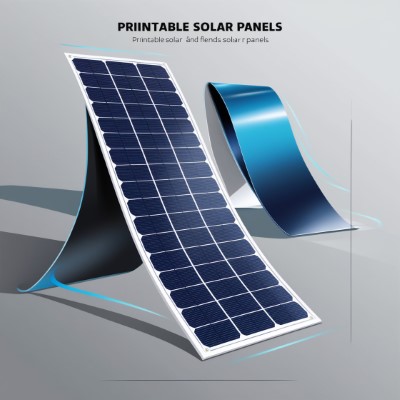Printable solar panels, also known as “organic photovoltaic (OPV) cells” or “printable photovoltaics,” are a type of solar technology that can be produced using printing techniques similar to those used in printing newspapers or T-shirts. This technology represents a significant advancement in the field of solar energy due to its potential for low-cost, large-scale production.
Key Features and Benefits:
- Flexibility: Printable solar panels can be made on flexible substrates, which means they can be bent or shaped to fit various surfaces, unlike traditional rigid solar panels.
- Lightweight: These panels are often lighter than conventional silicon-based panels, making them easier to transport and install.
- Low-Cost Production: The manufacturing process involves printing photovoltaic materials onto substrates, which can be done at lower costs compared to traditional methods. This could make solar energy more accessible.
- Scalability: The printing process can be easily scaled, allowing for the production of large areas of solar cells quickly and efficiently.
- Versatility: Because they can be printed on different surfaces, printable solar panels can be integrated into building materials, clothing, or even everyday objects.
Challenges:
- Efficiency: Currently, the efficiency of printable solar panels is lower than that of traditional silicon-based panels. However, ongoing research is working to improve this.
- Durability: Printable solar panels might not be as durable as traditional panels, especially in harsh environmental conditions.
- Lifespan: The lifespan of these panels may also be shorter, although advancements are being made to increase their longevity.
Applications:
- Wearable Technology: Integration into clothing for powering small devices.
- Building-Integrated Photovoltaics (BIPV): Incorporation into building materials like windows or walls.
- Portable Solar Solutions: Lightweight and flexible panels for use in remote areas or for portable charging solutions.
Printable solar panels are a promising development in renewable energy, with the potential to significantly expand the use of solar power in various applications.
Recent Developments in Printable Solar Panels:
Printable solar panels are an emerging technology with significant recent advancements. These solar panels are created using materials that can be printed onto flexible substrates, allowing them to be produced in various shapes and sizes, making them ideal for a wide range of applications.
Key Developments:
- Efficiency Improvements: The efficiency of printable solar panels has seen substantial progress. Researchers have been experimenting with materials like perovskite, which has shown efficiency rates of up to 25% in laboratory settings. This marks a significant leap from earlier prototypes that had lower efficiencies.
- Durability and Flexibility: Recent developments have enhanced the durability of printable solar panels, making them more resistant to environmental factors. These panels can now withstand bending, rolling, and even submersion in water without significant degradation, which was a challenge in earlier versions.
- Cost Reduction: Printable solar panels are becoming more cost-effective due to advancements in manufacturing processes. The ability to produce these panels using conventional printing techniques reduces the need for expensive clean-room environments typically required for traditional silicon-based panels.
- Integration with Various Surfaces: One of the most exciting developments is the integration of printable solar panels with different surfaces, including building materials like windows and roofing shingles. This allows for the generation of electricity without compromising the aesthetics or functionality of buildings.
- Scalability: Efforts are being made to scale up production to meet commercial demands. Companies and research institutions are working on mass production techniques that could see these panels become a common feature in consumer electronics, building-integrated photovoltaics, and even in portable energy solutions.
These advancements suggest that printable solar panels could play a significant role in the future of renewable energy, offering a versatile and affordable option for harvesting solar power in a wide range of settings.


